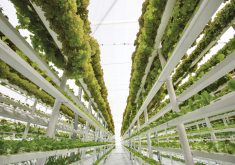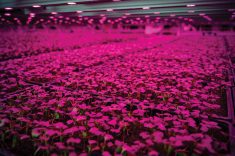There’s a lot more to growing a 2,537-pound pumpkin than you might think.
Like most other forms of farming, it’s just not a case of planting a seed, walking away and hoping for a good outcome.
“I could talk about pumpkins for just about as long as there is time,” said Don Crews of Lloydminster, who recently won the Smoky Lake Great White North Pumpkin Weigh-off.
Read Also

Moo translator and methane measures: There’s an app for that
Dalhousie University researchers use artificial intelligence to create new dairy farm apps that analyze cattle sounds and measure methane.
There’s genetics and seed selection, strategic pollination and close attention to nutrition.
Growing giant pumpkins is like a science experiment where a community of giant pumpkin devotees hunt for anomalies, share information and keep secret tips to themselves, said Crews, a bricklayer by trade who gardens on his family’s acreage.
“It’s like chaos, but it’s working,” he said. “So I’ve learned how to get a much bigger plant before I pollinate. In the old days, when I first started growing some 20 years ago, they figured the golden period for pollination was in early July. Now it’s early to mid-June.”
And, of course, parentage matters.
“A lot of this is genetics. I was growing 500-pound pumpkins when the world record was 1,100 pounds or so. The genetics are astoundingly better now,” he said. “We keep selecting genetics. Now, if someone grows a 2,000-pound pumpkin, everybody’s got to grow a seed from that one.”
[RELATED] Titans of the garden: Manitoba’s giant pumpkin growers
That means Crews is going to get a lot of requests, given his pumpkin is the largest ever grown in Canada and not far off the North American record of 2,560 pounds, recorded for a pumpkin grown in Minnesota this summer.
“This pumpkin weighs as much as a car,” he said. “It’s not quite the size of a car (but) you can’t get one in the back of your truck, that’s for sure.”

The reigning champ, according to Guinness World Records, is a 2,702-pound behemoth grown in 2021 in Italy as verified by the Great Pumpkin Commonwealth, the global association of giant pumpkin growers that sets standards and regulations for competitions.
However, a grower in England recently came close to smashing that record with a 2,900-pound pumpkin.
“It had a hole in it,” said Crews. “These things will split at the last moment, right? That’s what happened to him. So it’s not a record because it did not make it as a solid fruit.”
There’s no difference between giant pumpkins and other pumpkins when it comes to taste and nutrition, according to americangardener.net. However, giant pumpkins have more flesh than smaller ones, making them an excellent choice for food.
The website has tips for growing giant pumpkins, although you’ll need special seed varieties such as the Atlantic Giant (the famous variety patented by legendary Nova Scotian pumpkin breeder Howard Dill) if you want to be competitive.
Pumpkin vines grow quickly in warm weather and need plenty of space. They can reach over 20 feet. Soil should be fertile and well-drained for optimal root development. Also, pumpkins need at least eight hours of sunlight per day.
“If you live in a cooler climate, you can grow your pumpkin in a greenhouse or on a porch that gets full sun,” says the website.
Being a big shot in the world of competitive pumpkin growing means Crews fields a lot of questions.
“The average person will inquire, ‘How did you do this? How long does it take? Does it take years?’”
In fact, while the growing season lasts 150 to 160 days, much of the action takes place in a condensed period.
“They just grow really, really, really fast,” said Crews. “You have to do 60 to 70 pounds a day for a fairly good length of time in between as it ramps up, because it takes until 20 days after pollination before they really start to grow.
“And it’s pretty done by day 75 or 80 — you’ll get another few hundred pounds out of it after that. So you can imagine how fast they grow.”
While questions from the general public are mostly along the lines of ‘how do you do it,’ fellow pumpkin aficionados want technical details, such as vine length, the number of laterals (branches) before the pumpkin, lateral length and soil quality details.
Soil nutrition is the most critical part, Crews said.
“You try to have the best balance possible. I call it spoon feeding. Throughout the season I add a cup full or a couple of cups full of water-soluble fertilizer.
“You must have it pretty close to right to start with, or else you’re going to be chasing your tail.”
Crews credits his family, friends and employer with providing support. His wife, Tina, said he’s very determined.
“He takes more than just pumpkins to Smoky Lake,” she said. “He has taken squash, he has taken his field pumpkins that are different from the Atlantic Giant.”
It’s a labour of love but the seeds of that passion were planted long ago.
“I don’t think I would’ve become a gardener if my mom hadn’t always been planting stuff,” said Crew.















